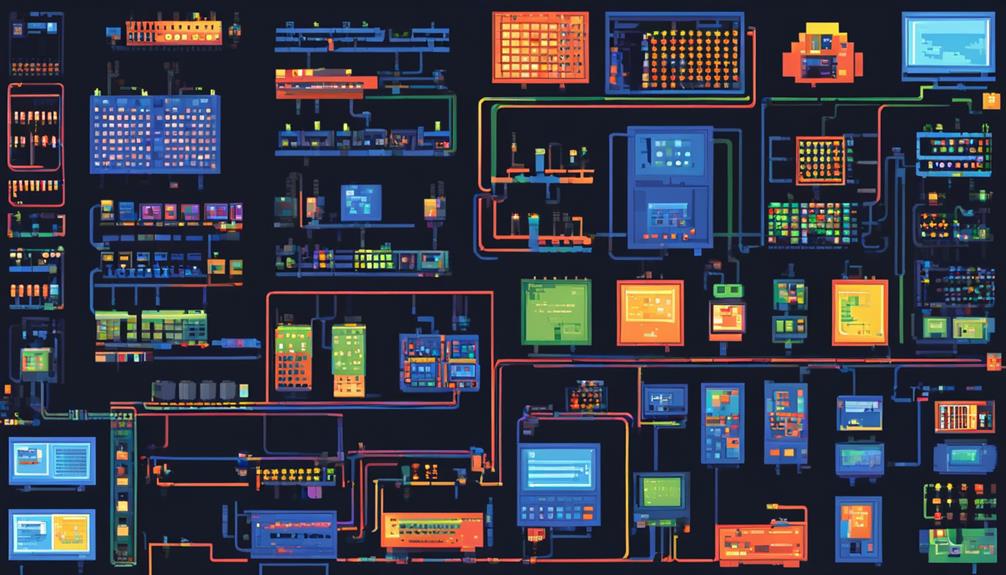The rapid growth of edge computing and the increasing number of edge devices being deployed pose significant challenges for organizations in monitoring and managing these devices effectively. With the complexity they add to IT systems, organizations need to equip their staff with the necessary skills to deploy, secure, and maintain edge devices.
This discussion will explore the importance of monitoring and managing edge devices, the key challenges involved, and the various tools and techniques available to overcome them. By delving into real-time data collection and analysis, optimizing performance and scalability, streamlining device configuration and updates, and exploring remote management solutions, this discussion aims to provide valuable insights into best practices for monitoring and managing edge devices.
So, let's explore the intricacies of this critical aspect of modern IT infrastructure and discover how organizations can navigate the complexities of monitoring and managing edge devices.
Key Takeaways
- Edge device monitoring is crucial for ensuring stability, security, and availability of edge devices.
- Device compatibility issues can be addressed by selecting management tools that support a wide range of edge devices and regularly monitoring network performance and power usage.
- Remote monitoring challenges can be overcome by utilizing AWS IoT Services, EdgeX Foundry, FNT Command, and JFrog Connect for modular systems and IoT platforms.
- Security and data protection can be ensured by implementing measures to safeguard data, ensuring uninterrupted power supply, and selecting tools with robust security features.
Edge Device Monitoring Importance

Effective monitoring of edge devices is crucial for ensuring the stability, security, and availability of these devices, as well as for managing and troubleshooting their connectivity, security, scalability, power consumption, and efficient data management. Edge device monitoring plays a vital role in managing and maintaining the health and performance of these devices.
One of the primary reasons why edge device monitoring is important is its ability to enable proactive maintenance and troubleshooting. By continuously monitoring the devices, organizations can identify any potential issues or anomalies and take appropriate action before they escalate into critical problems. This proactive approach ensures increased operational efficiency and reduced downtime, as potential disruptions can be addressed promptly.
Furthermore, remote management systems for edge devices offer various monitoring capabilities. Continuous bandwidth, latency, and power monitoring allow organizations to closely monitor the performance of their devices and identify any bottlenecks or issues that may affect their operations. In addition, security measures can be implemented to detect and prevent any unauthorized access or potential threats to the devices.
Edge device monitoring is also essential for backup and disaster recovery purposes. Efficient data management is a critical aspect of this process, ensuring that valuable data generated by edge devices is properly backed up and can be recovered in the event of a failure or disaster. By monitoring and managing the backup process, organizations can ensure the integrity and availability of their data.
Key Challenges in Device Management
Managing edge devices presents several key challenges that organizations must address.
One challenge is device compatibility issues, as different devices may have different operating systems or communication protocols.
Additionally, remote monitoring capabilities are crucial for edge devices located in remote areas, requiring efficient connectivity solutions.
Finally, security and data protection are critical concerns, as edge devices often handle sensitive data and must be safeguarded against unauthorized access or data breaches.
Addressing these challenges requires organizations to develop comprehensive strategies that encompass device compatibility, remote monitoring capabilities, and robust security measures.
Device Compatibility Issues
Compatibility issues between edge devices and management tools pose significant challenges in device management. Integration into existing monitoring software tools is crucial for ensuring device compatibility. Communication, bandwidth, and latency monitoring are essential for addressing device compatibility issues. Power monitoring is important for ensuring edge devices are compatible with power supply requirements. Device compatibility issues can be mitigated through robust data storage, security, and automation features.
| Issue | Solution |
|---|---|
| Integration into existing monitoring software tools | Ensure compatibility by selecting management tools that support a wide range of edge devices. |
| Communication, bandwidth, and latency monitoring | Monitor network performance to identify and resolve issues that may impact device compatibility. |
| Power monitoring | Regularly monitor power usage and ensure that edge devices are compatible with power supply requirements. |
Remote Monitoring Capabilities
Remote monitoring capabilities present significant challenges in device management due to the complexity of managing a diverse range of devices at the edge. Deploying, securing, and maintaining edge devices can be a significant challenge for staff, requiring specific skill sets and knowledge. Integration into existing monitoring software tools and communication, bandwidth, latency, and power monitoring further add to the complexity.
To address these challenges, various solutions and tools are available. AWS IoT Services and EdgeX Foundry offer remote monitoring and management capabilities for edge devices, providing security, local processing, and system management. Tools like FNT Command and JFrog Connect provide modular systems and IoT platforms for efficient management, control, and monitoring of edge devices, offering over-the-air updates, remote maintenance, and stability and security benefits.
These solutions help organizations effectively manage their edge devices and ensure seamless data management.
Security and Data Protection
Ensuring the security and protection of edge devices poses significant challenges in device management, particularly due to their distributed and remote nature. Organizations face the following key challenges in securing and protecting edge devices:
- Scalability: Managing and monitoring a large number of edge devices can be challenging. Organizations need robust systems and processes in place to efficiently handle the security requirements of each device.
- Data Protection: Edge devices generate a large amount of data, which needs to be efficiently managed and analyzed. This presents a significant challenge in terms of data protection. Organizations must implement appropriate measures to safeguard this data from unauthorized access or loss.
- Power Supply: Providing uninterrupted power supply for edge devices is crucial for their continuous operation. Organizations need to ensure reliable power sources or backup systems to prevent disruptions in monitoring and management activities.
Choosing the Right Edge Monitoring Tools
When selecting edge monitoring tools, it is crucial to prioritize integration with existing monitoring software for efficient management. Integration ensures seamless communication between edge devices and the monitoring system, allowing for centralized monitoring and control. Additionally, edge monitoring tools should offer communication and bandwidth monitoring capabilities to ensure uninterrupted connectivity in remote areas. This is particularly important as edge devices are often deployed in locations with limited network infrastructure.
Another important consideration when choosing edge monitoring tools is their latency and power monitoring capabilities. Low latency is crucial for real-time data processing at the edge, while power monitoring ensures uninterrupted operation even during power outages. These features are essential for managing edge devices effectively and ensuring uninterrupted data collection and processing.
Security is a paramount concern when it comes to edge devices. Therefore, it is essential to select edge monitoring tools that offer robust security features. These may include hardware root of trust, which establishes a secure foundation for the device's security, as well as regular firmware updates and security patches. These measures help protect edge devices from potential vulnerabilities and ensure the overall security of the network.
Lastly, remote management features are highly desirable in edge monitoring tools. Leveraging edge analytics for proactive maintenance and troubleshooting can significantly reduce downtime and improve operational efficiency. Remote management capabilities allow administrators to monitor and manage edge devices from a central location, reducing the need for on-site visits and minimizing maintenance costs.
Effective Techniques for Device Monitoring

Effective device monitoring at the edge requires implementing real-time monitoring techniques and proactive issue detection.
By continuously monitoring device performance, organizations can detect and address potential issues before they escalate, ensuring optimal operations and minimizing downtime.
Real-time monitoring enables organizations to gather valuable data on device performance and behavior, allowing them to make informed decisions and take proactive measures to optimize device performance and enhance overall system reliability.
Real-Time Device Monitoring
To achieve optimal real-time device monitoring at the edge, seamless integration with existing monitoring software tools is essential. This integration allows for a unified view of all devices and enables efficient management and troubleshooting.
Additionally, communication and bandwidth monitoring play a crucial role in real-time device monitoring. By monitoring network traffic and analyzing bandwidth usage, potential bottlenecks and network congestion can be identified and addressed promptly.
Latency monitoring is another important aspect of real-time device monitoring. It helps in identifying delays in data processing, allowing for timely action to optimize performance.
Proactive Issue Detection
Building upon the importance of real-time device monitoring at the edge, the next crucial aspect to discuss is implementing effective techniques for proactive issue detection. By utilizing remote management and monitoring tools, organizations can track the status of their edge devices, monitor hardware resources, and receive alerts for potential issues. Employing edge analytics enables predictive maintenance and troubleshooting, allowing organizations to identify and address issues before they escalate. Over-the-air updates and remote control tools further enhance proactive issue detection by enabling quick problem resolution. To efficiently control and monitor edge devices, organizations can leverage robust IoT platforms like JFrog Connect, ensuring stability and security. The following table summarizes the techniques for proactive issue detection:
| Technique | Description |
|---|---|
| Remote monitoring | Track device states and hardware resources, receive alerts |
| Edge analytics | Predictive maintenance and troubleshooting for issue identification |
| Over-the-air updates | Quick problem resolution through remote updates |
| Remote control tools | Enable remote management and quick issue resolution |
Implementing these techniques enables organizations to detect and address potential issues proactively, ensuring the smooth functioning of their edge devices.
Real-Time Data Collection and Analysis
Real-time data collection and analysis is a critical process that enables organizations to gain immediate insights into the performance and behavior of edge devices. By collecting data from these devices in real-time, organizations can make instant decisions based on the latest information. This process involves continuously gathering and processing data from edge devices in a timely manner to extract actionable information.
Real-time data collection and analysis offer several benefits for organizations:
- Instant decision-making: By accessing real-time data, organizations can quickly identify and respond to issues or opportunities as they occur at the edge. This allows for proactive decision-making and the ability to address problems before they escalate.
- Up-to-the-minute information: Real-time data collection and analysis provide organizations with the most current information about the performance and behavior of edge devices. This up-to-the-minute information is crucial for effective decision-making and can help optimize device performance.
- Facilitates monitoring and management: By continuously collecting and analyzing data in real-time, organizations can monitor the health and status of edge devices more effectively. This enables them to detect anomalies, identify trends, and take proactive measures to ensure optimal device performance.
Implementing Proactive Device Maintenance

Implementing proactive device maintenance involves leveraging predictive maintenance techniques and remote device monitoring.
By continuously monitoring bandwidth, latency, and power, potential issues can be anticipated and prevented.
This proactive approach enables organizations to identify and address device issues before they escalate, ensuring efficient device management and optimal performance.
Predictive Maintenance Techniques
Leveraging data and analytics, predictive maintenance techniques enable organizations to implement proactive device maintenance strategies, reducing downtime and increasing operational efficiency. By using predictive maintenance, organizations can schedule maintenance activities at optimal times, reducing costs and preventing unexpected breakdowns.
This is particularly beneficial for edge devices, as they can be monitored for early signs of potential failures, allowing for predictive maintenance interventions. Implementing predictive maintenance techniques requires the integration of monitoring tools to collect and analyze real-time data from edge devices.
This data is then used to identify patterns and anomalies that indicate potential equipment failures. By detecting these issues early on, organizations can take proactive measures to address them before they lead to costly downtime or operational disruptions.
Remote Device Monitoring
Remote device monitoring plays a crucial role in implementing proactive device maintenance strategies by enabling remote access and control of edge devices. It involves continuous monitoring of bandwidth, latency, and power usage to ensure optimal performance. By leveraging remote monitoring, businesses can remotely diagnose and troubleshoot issues, reducing downtime and improving operational efficiency. Implementing security measures such as hardware root of trust, firmware updates, and security patches is essential to protect edge devices from potential vulnerabilities. Additionally, remote device monitoring allows businesses to leverage edge analytics for proactive maintenance and troubleshooting. This provides a competitive advantage by enabling real-time insights and the ability to address issues before they impact operations. Overall, remote device monitoring enhances device management, increases reliability, and ensures smooth functioning of edge devices.
| Benefits of Remote Device Monitoring |
|---|
| – Enables remote access and control |
| – Reduces downtime |
| – Improves operational efficiency |
| – Enhances device management |
| – Provides real-time insights |
Ensuring Security and Data Privacy
To ensure the utmost security and data privacy in edge device management, it is crucial to implement robust security measures and regularly update and monitor these devices for any potential vulnerabilities or breaches. With the increasing use of edge computing devices in various industries, securing these devices has become a critical priority.
Here are three key measures to ensure security and data privacy in edge device management:
- Implement strong access controls: Limiting user access to edge devices is essential in preventing unauthorized actions and potential security breaches. By implementing access controls, such as strong authentication mechanisms and role-based access, organizations can minimize the risk of unauthorized access to data stored or processed on these devices.
- Regularly update and patch edge devices: Edge devices, just like any other technology, are prone to vulnerabilities. Regularly updating and patching these devices with the latest security patches is crucial to address any known vulnerabilities and protect sensitive data. This practice helps ensure that edge devices are equipped with the latest security features and defenses against emerging threats.
- Secure data transmission: When edge devices communicate with the central data center or other IoT edge devices, it is important to secure the transmission of data. Utilizing encryption and secure communication protocols, such as SSL/TLS, ensures that data transmitted between edge devices and the central network remains confidential and protected from unauthorized interception or tampering.
Optimizing Performance and Scalability

Implementing optimization strategies is crucial for enhancing the performance and scalability of edge devices. Efficiently integrating edge devices into existing monitoring software tools is essential for optimizing their performance and scalability. By utilizing communication, bandwidth, and latency monitoring tools, organizations can identify and address performance bottlenecks at the edge. This enables them to optimize the usage of available bandwidth and ensure smooth operation of edge devices.
To further optimize performance and scalability, implementing power monitoring and management solutions is imperative. This allows organizations to optimize energy usage and enhance the scalability of their edge deployments. By monitoring power consumption and implementing power-saving measures when necessary, organizations can ensure the efficient operation of their edge devices.
Automation and backup solutions also play a vital role in optimizing performance and scalability. By leveraging automation, organizations can streamline operations and reduce manual intervention, leading to improved efficiency. Additionally, implementing backup solutions ensures the reliability and scalability of edge device operations. In the event of a failure or downtime, backup systems can quickly restore functionality, minimizing disruptions and maintaining optimal performance.
To provide a concise overview of the strategies for optimizing performance and scalability of edge devices, the following table summarizes key points:
| Optimization Strategy | Description | Benefits |
|---|---|---|
| Integration with tools | Efficient integration into existing monitoring software tools | Optimized performance and scalability |
| Communication monitoring | Utilization of communication monitoring tools to identify bottlenecks | Optimized bandwidth usage |
| Power monitoring and | Implementation of power monitoring and management solutions | Enhanced energy usage and scalability |
| management solutions | ||
| Automation and backup | Leveraging automation and backup solutions for streamlined operations and reliability | Improved efficiency and scalability |
Streamlining Device Configuration and Updates
To streamline the configuration and updates of edge devices, organizations can implement automated device configuration and utilize over-the-air updates for efficient management and maintenance.
Automated device configuration allows for the quick and standardized deployment of edge devices, reducing the time and effort required for manual configuration. This not only improves efficiency but also ensures consistency across multiple devices.
Utilizing over-the-air updates enables organizations to remotely manage and update edge devices without the need for physical access. This is particularly beneficial for devices deployed in remote or difficult-to-reach locations. Over-the-air updates can be scheduled and deployed at a convenient time, minimizing disruption to ongoing operations. Additionally, these updates can patch security vulnerabilities and introduce new features, ensuring that edge devices are always up to date.
Incorporating monitoring tools into the management process allows organizations to track the performance of edge devices. These tools provide valuable insights into factors such as device health, bandwidth usage, and power consumption. By monitoring these metrics, organizations can proactively identify and address any issues that may arise, ensuring optimal performance and minimizing downtime.
In order to efficiently manage edge devices, organizations can leverage remote management systems. These systems enable centralized control and monitoring of edge devices, ensuring security, efficiency, and proactive maintenance. Solutions like JFrog Connect for IoT edge device management provide scalability and remote control capabilities, allowing organizations to easily manage and maintain a large number of edge devices.
Remote Management Solutions for Edge Devices

Remote management solutions for edge devices play a crucial role in streamlining and simplifying the oversight and control of various edge computing devices. These solutions are designed to integrate into existing monitoring software tools and provide a range of features to ensure efficient management of edge devices.
One important aspect of remote management solutions is monitoring. These solutions should offer features such as communication and bandwidth monitoring, latency monitoring, power monitoring, data storage, security, automation, and backup/disaster recovery. By monitoring these metrics, organizations can ensure optimal performance, identify potential issues, and take proactive measures to address them.
Several providers offer remote management solutions specifically tailored for edge devices. For example, AWS offers IoT services like Greengrass, IoT Core, IoT Device Defender, and IoT Device Management. These services enable organizations to securely manage and monitor their edge devices at scale, ensuring seamless connectivity and efficient operations.
Another notable solution is EdgeX Foundry, which provides a two-way transformation engine between edge devices and business applications. This enables effective communication and management between edge devices and larger systems, facilitating data flow and control.
FNT Command is another modular system designed for managing, controlling, and supporting infrastructure assets. It optimizes device interaction, offering various pricing options for flexibility. With FNT Command, organizations can efficiently manage their edge devices and ensure smooth operations.
Best Practices for Monitoring and Managing Edge Devices
Monitoring and managing edge devices requires a comprehensive approach to ensure efficient oversight and control of these complex devices. With the increasing adoption of edge computing, it is crucial for organizations to follow best practices for monitoring and managing their edge devices.
Here are three key practices to consider:
- Integration with existing monitoring tools: It is essential to integrate edge devices into existing monitoring tools used in data centers. This allows for centralized monitoring and management, providing a holistic view of the entire infrastructure. By leveraging these tools, organizations can ensure consistent monitoring and timely detection of any issues or anomalies with their edge devices.
- Comprehensive monitoring capabilities: Effective monitoring of edge devices involves monitoring various aspects such as communication and bandwidth, latency, power consumption, data storage, security, automation, and backup. By utilizing monitoring solutions that offer these capabilities, organizations can proactively identify and address potential issues, ensuring optimal performance and reliability of their edge devices.
- Robust disaster recovery and backup strategies: Edge devices are prone to various risks, including hardware failures, natural disasters, and cyber attacks. Implementing robust disaster recovery and backup strategies is crucial to minimize downtime and data loss. This includes regular backups, redundant systems, and failover mechanisms to quickly restore operations in case of any disruptions.
Frequently Asked Questions
What Is Edge Device Management?
Edge device management is the process of overseeing and controlling various devices at the edge of a network. It involves deploying, securing, and maintaining these devices, which can present complex challenges for organizations.
Edge device management is crucial for ensuring edge device security, as well as optimizing performance and efficiency. It allows organizations to monitor and manage their edge devices effectively, addressing the challenges that arise in this dynamic environment.
What Does Edge Monitor Do?
Edge monitoring is a crucial aspect of managing IoT devices at the network's edge. It offers several advantages such as integration into existing monitoring software, communication and bandwidth monitoring, latency monitoring, power monitoring, data storage, security, automation, backup, and disaster recovery.
It plays a vital role in ensuring the performance and security of edge devices. However, implementing edge monitoring can present challenges, including complexity in managing a large number of devices, ensuring real-time monitoring, and addressing connectivity issues.
What Is Edge Control in Networking?
Edge control in networking refers to the comprehensive management and oversight of edge devices in an edge networking environment. It involves the deployment, security, and maintenance of these devices, as well as their integration into the existing IT system.
The goal of edge control is to optimize the performance and efficiency of edge networking by reducing the computing load on data center infrastructure and enabling faster response times and reduced latency.
Effective edge control is crucial for the success of edge computing and its benefits in data handling, latency reduction, and uptime.
What Are the Requirements for Edge Devices?
Edge devices have specific requirements to ensure efficient deployment and integration into existing IT systems. These requirements include:
- Scalability: Edge devices should be able to accommodate the addition of new devices without impacting performance. This enables the system to scale as the number of edge devices increases.
- Low power consumption: To optimize energy usage and prolong device lifespan, edge devices should consume minimal power. This is especially important as edge devices are often deployed in remote or inaccessible locations where power supply may be limited.
- Real-time processing capabilities: Edge devices need to have the ability to process data in real-time. This enables quick and efficient data processing at the edge, reducing latency and improving overall system performance.
These features are essential for edge devices to effectively support edge computing and meet the demands of modern IoT applications.

